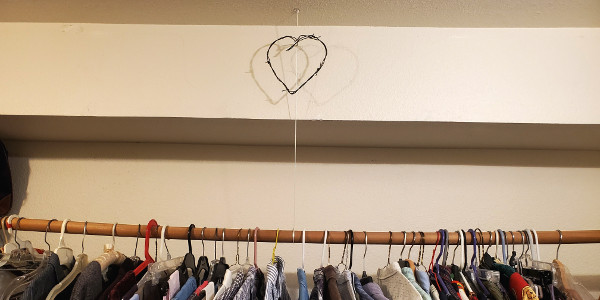Tension and Pressure
The wooden pole in the storage room was sagging under the weight of the rarely used clothes we’d hung on it. So I drilled a hole in the ceiling and popped in a sturdy molly bolt, to which I tied a nylon cord. Then I wound the other end around the middle of the pole. Finally, I cinched up the cord and tied it tight, which straightened out the bend. The pole felt much sturdier, and the clothes hung better.
This was a satisfying fix, but as I put away my tools I felt a little uneasy. It took me a while to figure out why, but I finally did: I was acutely aware of the newly created tension in the cord. It was stretched so tight that when I strummed it, it vibrated like the C string of a cello. The entire pole was under the influence of this tension. And so was the drywall in the ceiling, resisting the downward pressure of the wings of the molly bolt. I could feel it! Disturbingly, I realized that this considerable force would remain active for as long as the cord stayed in place. That could well be years. Perhaps many years.
I’ve been doing a lot of other home projects lately. Almost all of them produce tension or pressure. Every time I screw two panels of a bookcase together, I’ve created pressure. Every time I hang a door, or earthquake-proof a bookcase by strapping it to a wall, there’s tension. Every time I bolt a mower blade in place, couple two electric wires together with a wire nut, or replace a board on the deck, pressure.
Tension and pressure are everywhere. My house, for example, stays together because of them—I become a little giddy when I think of all the joists and studs and beams being held in place by a vast army of screws, nails, and bolts. Layer after layer of balanced forces are keeping everything stable: the roof, the walls, the floors, the stove and fridge, the bed on which I sleep.
When I drive my car I’m conscious of being surrounded by a complex array of forces: the pressure I create by sitting on my seat, that of my seat against the chassis, the chassis against the wheels, and the wheels against the road. To say nothing of the incredible force being generated by the explosions within the cylinders when I step on the gas. Sometimes it’s hard to fathom why the car doesn’t simply blow apart as I drive down the interstate.
Omnipresent pressure and tension aren’t of course limited to things made by humans. When a storm blows up from the northeast, the big Doug fir in our yard sways ominously. At times I can sense the stress of the branches as they push back against the wind, and the pressure on the base of the trunk as it’s stabilized by the roots clutching frantically at the soil to keep the tree upright. But even on a beautiful day, when there’s no wind and the bay is smooth as glass, all is not really placid. Superficially in equipoise, competing forces are everywhere trying to get the upper hand: in the bay, the weight of the water is pushing down on the seabed below, while on the shore the soil and sand are pressing heavily on the bedrock. These components of the crust are mashing down on the molten outer core, which in turn is squeezing down on the solid inner core.
While my mind is subterranean, I can’t help but think of the upward force of that molten core, liable to increase to the point of volcanic activity, so common in this part of the world. To say nothing of the tectonic plates of the Cascadia Subduction zone. They’re constantly butting heads with incredible energy, gearing up to produce the inevitable Big One. (Good thing I bolted the bookcase to the wall!).
And when you think about it, tension and pressure are ubiquitous within our bodies too. The pressure exerted by our beating hearts sends blood coursing through a complex maze of arteries and veins, nourishing our tissues. As we’re all too aware, if the blood pressure is too high, it can cause great mischief in our hearts and brains and blood vessels. The forces that are intermittently generated within our bladder and intestines allow us to eliminate waste. Muscle tension, even at rest, keeps our bones stable, and the tension in our ligaments and fascia keep our muscles and organs tidily in place. Tension across an ear drum allows it to vibrate (sort of like the cord holding up the clothes pole), enabling us to hear. And on and on. Sometimes, lying quietly in bed, I’m very aware of this symphony of forces at play in my body. Although I know that they all work together to promote normal functioning, this doesn’t necessarily enhance my relaxation.
So how can we peacefully live our lives when we’re conscious of the sometimes-extreme pressure and tension in the things we build, in the natural world, and even within our own bodies? Well first of all, we can be happy that these forces are there—otherwise we wouldn’t be. If gravity and friction were somehow repealed, our houses, our machines, our entire world, and us, would just disperse into space. So celebrate all the pressure and tension, usually in benign equilibrium, that allow our world—including that cord which is so patiently holding up our spare clothes–to exist. Be prudent when messing with those forces. And most of the time, just ignore them.




Ken, Another terrific post! After your fascinating description of omnipresent tension & pressure, your final paragraph provides hope and relief!
Cheers, Carl
I always love reading your musings on the things in life we normally take for granted or simply never ponder. Tension and pressure – a good parable for this year!
Agree with what Hillary said – I look forward to a follow-up exploring tension and pressure at the socio-cultural level 😉
Yes, I agree with Carl, Hillary, and Emily. I really like the summary in the last paragraph, and especially the last three sentences. Well said!
Well, now I’m stressed… Hopefully my brains will stay in my head and nothing else falls out of me or onto me anytime soon! Meanwhile, I’m strangely concerned about your closet…